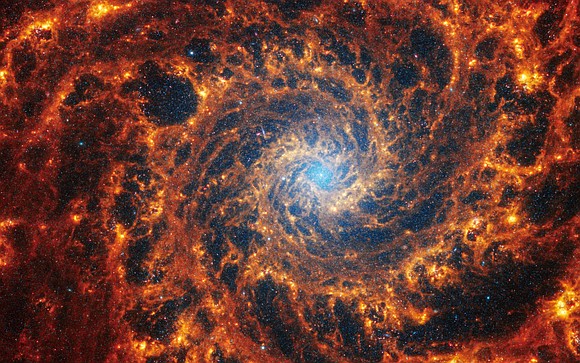Millions of stars glow in James Webb's telescope - unprecedented spiral galaxies portrait
Ashley Strickland, CNN | 2/1/2024, 11:10 a.m.

The James Webb Space Telescope has captured scintillating portraits of 19 spiral galaxies — and the millions of stars that call them home — in unprecedented detail never seen before by astronomers.
Webb’s singular ability to observe the universe in different wavelengths of infrared light, such as near-infrared and mid-infrared, showcases the stars, gas and dust within the intricate structure of each galaxy.
Astronomers believe that about 60% of all galaxies are spiral galaxies — and our solar system resides in one of the spiral arms of the Milky Way galaxy. Webb’s observations can help astronomers better understand star formation and the evolution of spiral galaxies like our own.
Seen face-on, each galaxy in the new images has spiral arms laden with stars. The center of each galaxy features clusters of old stars or supermassive black holes.
The observations were made as part of the PHANGS, or the Physics at High Angular resolution in Nearby GalaxieS, project. More than 100 astronomers around the world participate in the program, which also looks at data from the Hubble Space Telescope, the European Space Observatory’s Very Large Telescope’s MUSE instrument and the Atacama Large Millimeter/submillimeter Array in Chile.
Data from the different telescopes enables astronomers to make observations across different wavelengths of visible, ultraviolet and radio light. Adding Webb’s infrared insights can help address some of the observational gaps.
“Webb’s new images are extraordinary,” said Janice Lee, PHANGS core member and a project scientist for new missions and strategic initiatives at the Space Telescope Science Institute in Baltimore, in a statement. “They’re mind-blowing even for researchers who have studied these same galaxies for decades. Bubbles and filaments are resolved down to the smallest scales ever observed, and tell a story about the star formation cycle.”
Peering inside the spirals
Astronomers used Webb’s Near-Infrared Camera to observe millions of stars, seen in sparkling blue, grouped together in clusters and spread throughout the arms of the 19 galaxies as well. Meanwhile, Webb’s Mid-Infrared Instrument puts the spotlight on glowing dust surrounding the stars, as well as red still-forming stars cocooned in the very gas and dust that aids stellar growth.
“These are where we can find the newest, most massive stars in the galaxies,” said Erik Rosolowsky, PHANGS core member and a professor of physics at the University of Alberta in Edmonton, in a statement.
The spiral arms are practically incandescent with orange and red gas in Webb’s imagery. The images will be used to help astronomers determine the distribution of gas and dust in spiral galaxies, as well as how galaxies both nurture and cease the formation of stars.
“These structures tend to follow the same pattern in certain parts of the galaxies,” Rosolowsky said. “We think of these like waves, and their spacing tells us a lot about how a galaxy distributes its gas and dust.”
Webb also captured large, spherical shell-shaped voids among the galactic gas and dust that were likely sculpted by the explosions of stars.
“These holes may have been created by one or more stars that exploded, carving out giant holes in the interstellar material,” said Adam Leroy, PHANGS core member and a professor of astronomy at the Ohio State University in Columbus, in a statement.
The anatomy of a galaxy
Astronomers think that galaxies form from the inside out. Star formation begins at the galactic center before rippling across the arms in a spiral. That means a star’s distance from the heart of the galaxy is relative to its age, so younger stars are likely farther from the galactic core. Groupings of blue stars near the centers of each galaxy indicate older stars.
Meanwhile, some galaxies have pinkish-red spikes near their centers.
“That’s a clear sign that there may be an active supermassive black hole,” said Eva Schinnerer, PHANGS core member and a staff scientist at the Max Planck Institute for Astronomy in Heidelberg, Germany, in a statement. “Or, the star clusters toward the center are so bright that they have saturated that area of the image.”
Scientists are most excited about studying the massive number of stars revealed by Webb’s new images, according to Leroy.
“Stars can live for billions or trillions of years,” Leroy said. “By precisely cataloging all types of stars, we can build a more reliable, holistic view of their life cycles.”



